North Farallon Island is a remote and uninhabited island located off the northern coast of California. Known for its stunning beauty and wildlife, the island is home to many bird species that nest and thrive in the rugged terrain.
Due to its isolation and protected status, North Farallon Island is an important breeding ground for migratory and seabirds that utilize its rocky cliffs and surrounding waters for foraging and breeding.
The bird populations on North Farallon Island have been well-studied and monitored for several decades, providing invaluable insight into these magnificent creatures’ behavior, ecology, and conservation status.
In this article, we will explore the fascinating world of birds on North Farallon Island and shed light on the importance of preserving this unique ecosystem.
20 Birds in North Farallon Island
North Farallon Islands, part of the Farallon Islands off the San Francisco, California coast, are a crucial habitat for various bird species, particularly seabirds. Here are 20 birds that can be found in this region:
1. Rock Dove
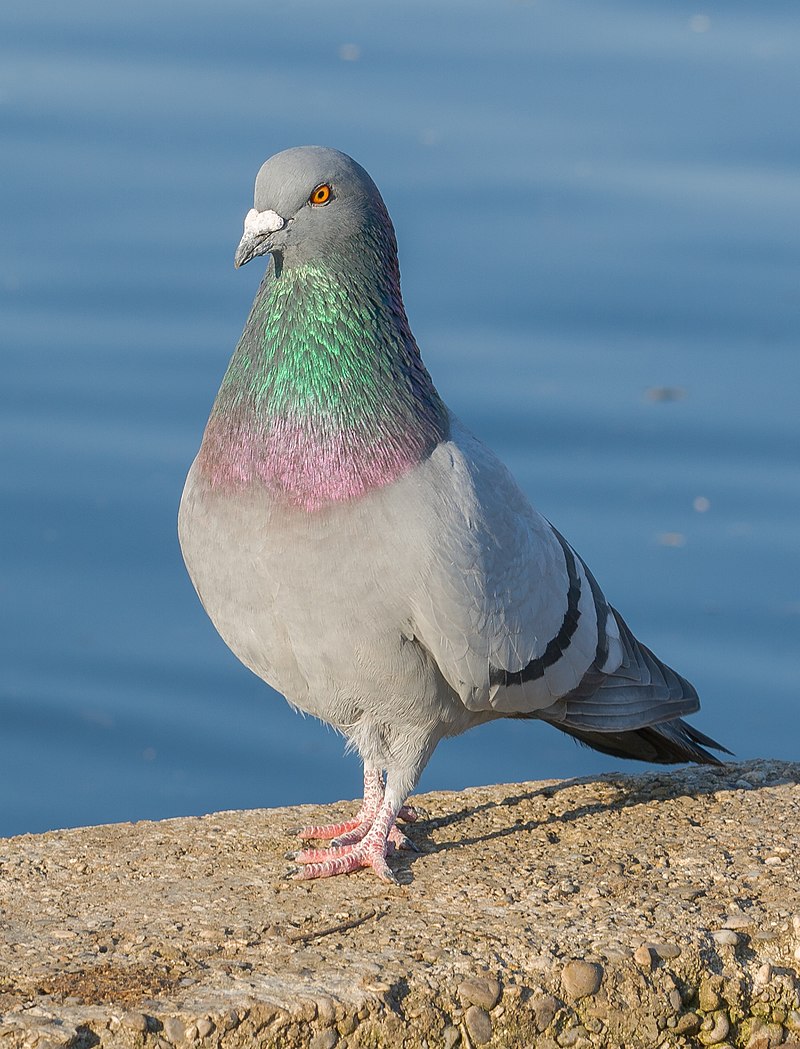
Rock dove, also known as Rock Pigeon or Common Pigeon, is a member of the bird family Columbidae.
It is considered to be an important creature worldwide due to its domestication by humans centuries ago, resulting in the modern-day Domestic pigeon, which descends from this species.
Its population has increased over time because some domestic pigeons have escaped captivity and joined wild populations.
The rock dove can most easily be identified by its prominent blue-grey feathers, darker bars on the wings and tail, and two black bands on each wing.
They are typically found in large flocks near cliffs or buildings but may also inhabit rural habitats such as open fields and meadows if there’s enough food available for them nearby.
Although they don’t migrate far distances like other birds, their numbers increase significantly during winter months.
When more food sources become available close by, they won’t need to travel too far away from their home base for nourishment.
Scientific classification:
| Kingdom | Animalia |
| Phylum | Chordata |
| Class | Aves |
| Order | Columbiformes |
| Family | Columbidae |
| Genus | Columba |
| Species | C. livia |
Also Featured In: Common Birds in India, Italian Birds You Should Know
2. Mourning Dove
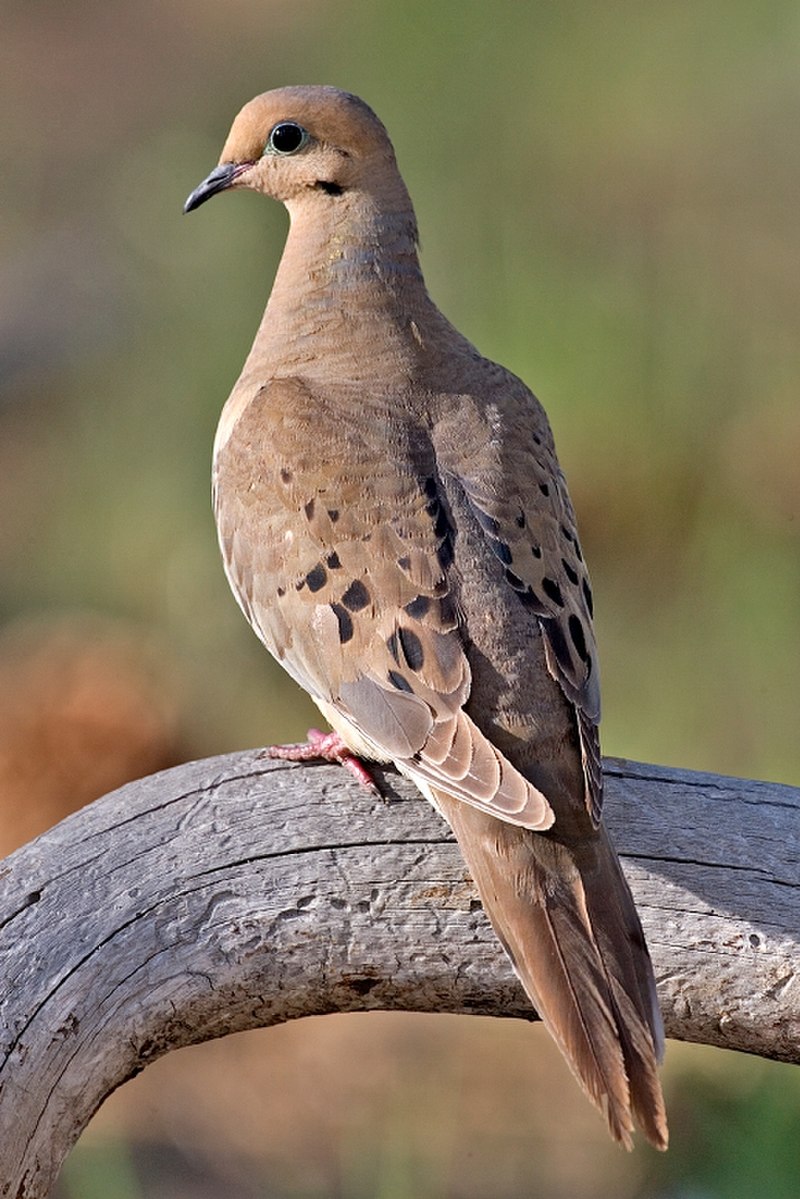
The Mourning Dove is a breathtakingly beautiful bird. It has stunning gray and brown feathers with white-tipped wings, giving it an elegant appearance. Its long tail also adds to its graceful look in flight.
A symbol of peace and serenity, they are abundant across North America and can be found in gardens or open fields throughout the year.
As well as being popular game birds for hunters, they feed on grains such as wheat and millet, providing important food sources for wildlife species, including foxes, coyotes, skunks, and raccoons.
These doves have a distinctive cooing sound that can often echo through woodlands during summer evenings, making them one of nature’s greatest treasures.
Scientific classification:
| Kingdom | Animalia |
| Phylum | Chordata |
| Class | Aves |
| Order | Columbiformes |
| Family | Columbidae |
| Genus | Zenaida |
| Species | Z. macroura |
Also Featured In: Most Common United States Birds, Most Common Winter Birds
3. Yellow-Rumped Warbler
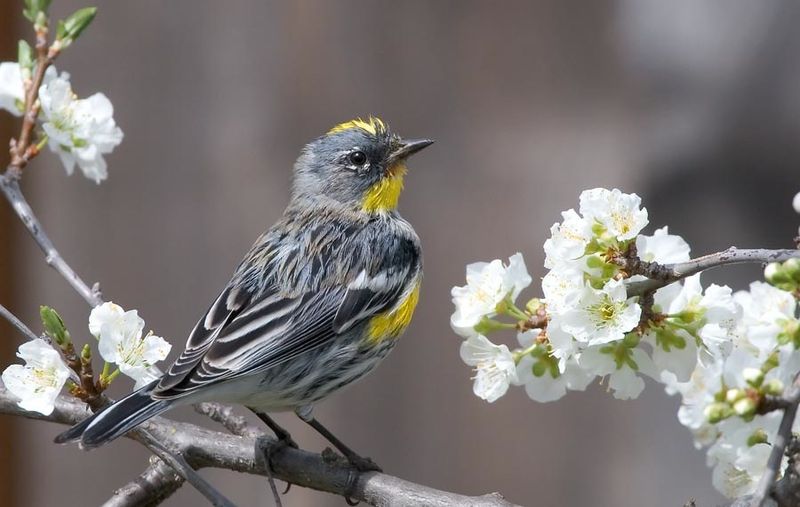
The Yellow-rumped Warbler (Setophaga coronata) is a migratory bird species that can be found throughout North America.
It has an extensive range, from the Pacific and Atlantic coasts of the US to Canada and Central America, with a concentration in northern areas during the breeding season.
These birds migrate southwards for wintering grounds, where they find plentiful food sources such as insects and berries.
They are easily identified by their yellow patches on either side of their tails, along with white underparts, gray back feathers, and two distinct crown stripes.
One black or greyish-brown above the eyes extends towards its neck, banded in yellow or light brown.
Furthermore, these warblers have strong legs, which allow them to cling onto branches while hunting for prey, making them adept at maneuvering through tree cover quickly.
Altogether, this makes the Yellow-rumped Warbler an attractive backyard visitor year-round.
Scientific classification:
| Kingdom | Animalia |
| Phylum | Chordata |
| Class | Aves |
| Order | Passeriformes |
| Family | Parulidae |
| Genus | Setophaga |
| Species | S. coronata |
Also Featured In: Most Popular Bird Species in North America, Birds Live Near San Diego
4. Eurasian Collared Dove
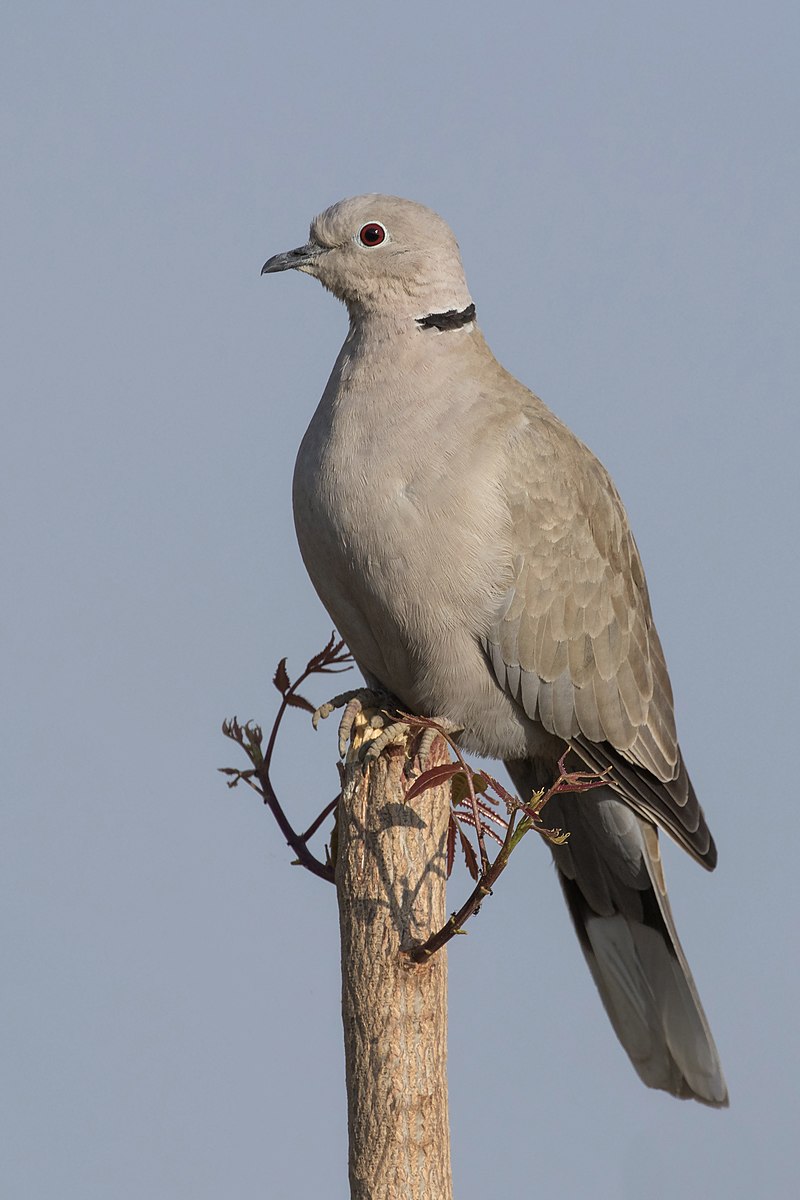
The Eurasian collared dove is a species of bird native to Europe and Asia, with its range expanding through introduction in Japan, North America, and islands in the Caribbean.
It has become so widespread that it is listed as Least Concern on the IUCN Red List. The scientific name for this bird was proposed by Hungarian naturalist Imre Frivaldsz – Columba decaocto.
This beautiful creature typically measures between 33-37 cm from tip to tail feathers, displaying an overall greyish brown plumage; they also have a distinctive black half collar around their neck, which gives them their common name.
These birds are mainly found inhabiting open woodlands or agricultural lands near human settlements where there’s plenty of food available, such as grain fields or gardens where fruits can be eaten off trees.
With a vast global population trend increasing steadily yearly, these birds make great additions to many backyards worldwide.
Scientific classification:
| Kingdom | Animalia |
| Phylum | Chordata |
| Class | Aves |
| Order | Columbiformes |
| Family | Columbidae |
| Genus | Streptopelia |
| Species | S. decaocto |
Also Featured In: Top Birds Found in Mexico, Turkey Birds You Should Know
5. Sandhill Crane
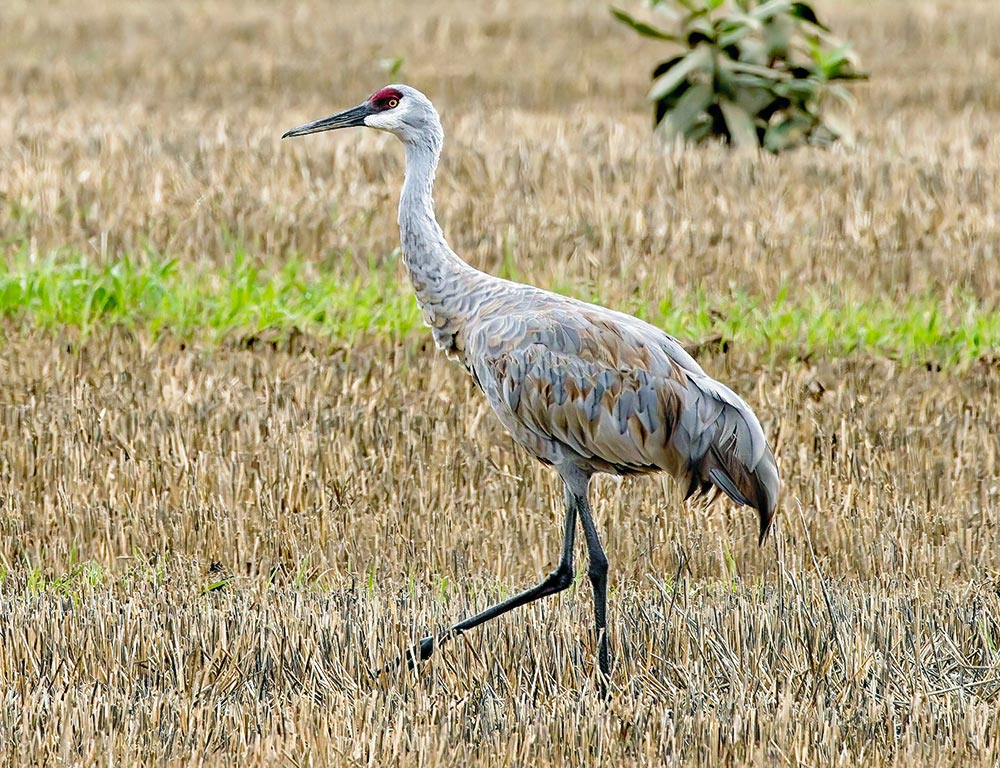
Sandhill Cranes are a large crane species native to North America and northeastern Siberia. They are known for their distinctive calls, long legs, and long necks.
These birds typically inhabit wetland areas like the Platte River in Nebraska’s Sandhills on the Great Plains.
In Central Florida, they often gather at the edges of bodies of water such as lakes or rivers.
During the breeding season, sandhill cranes can be seen performing elaborate courtship dances that involve bowing and jumping in unison with their partner.
Their diet consists mainly of plant material, including grains, roots, tubers, and aquatic plants, which they obtain by pecking or digging into mudflats using their bill or feet.
With an average lifespan between 10-20 years, these majestic creatures make great additions to any wetland habitat.
Scientific classification:
| Kingdom | Animalia |
| Phylum | Chordata |
| Class | Aves |
| Order | Gruiformes |
| Family | Gruidae |
| Genus | Antigone |
| Species | A. canadensis |
Also Featured In: Most Common Types of Birds Found in Cuba, Flocks Birds around Us
6. Common Murre
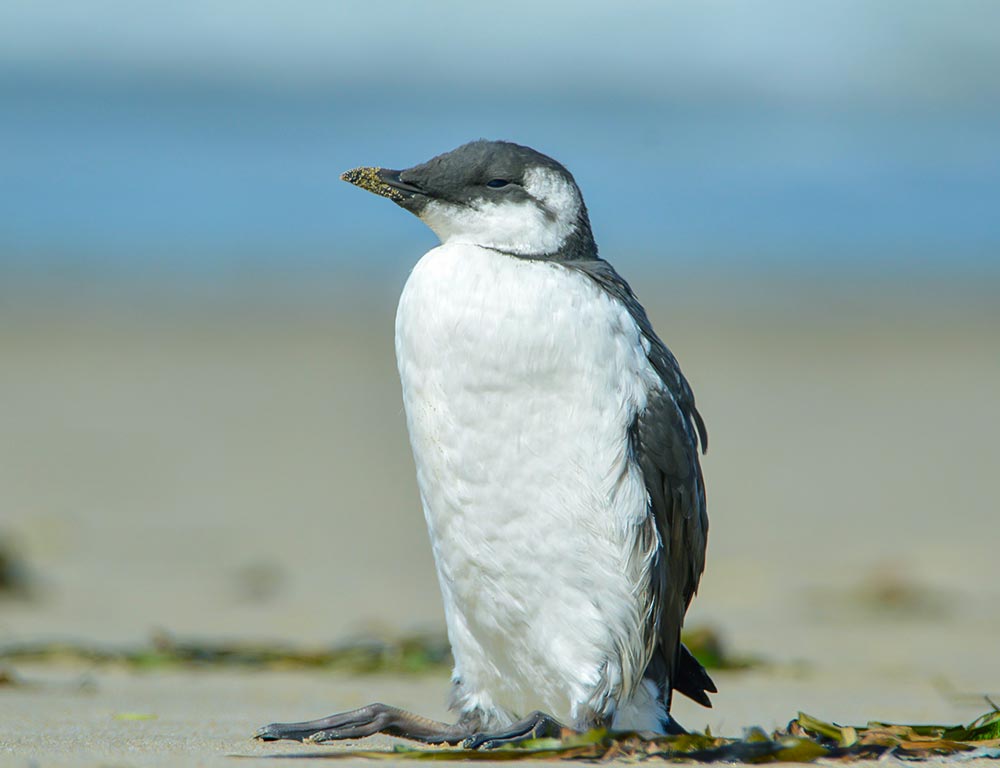
The Common Murre, also known as a Common Guillemot, is an Arctic and Boreal seabird that can be seen in the North Atlantic and North Pacific oceans.
It has a stocky body with white underparts, black upperparts, and striking yellow legs.
They are relatively large birds compared to their relatives but have weak flying abilities – they fly fast but not very agilely.
Their agility lies underwater instead, where they can dive deep into the ocean depths for food, such as fish, crustaceans, or mollusks.
During breeding season, these birds come ashore on rocky cliffsides or islands, creating burrows for nesting purposes.
The female lays one egg yearly, and both parents share incubation duties until hatching around 30 days later.
Scientific classification:
| Kingdom | Animalia |
| Phylum | Chordata |
| Class | Aves |
| Order | Charadriiformes |
| Family | Alcidae |
| Genus | Uria |
| Species | U. aalge |
Also Featured In: Norway Birds, Most Common Scotland Birds
7. Eurasian Dotterel
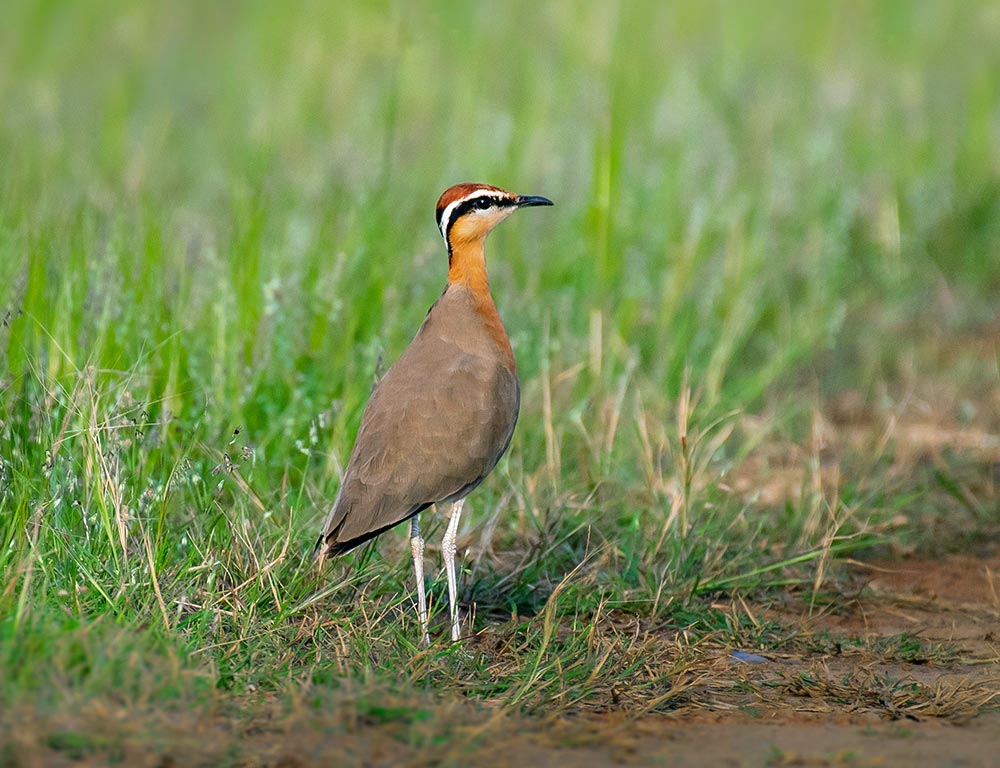
The Eurasian Dotterel is a small wader bird in the plover family. In breeding plumage, it has brown and black streaking with a broad white eye stripe and an orange-red chest band.
The female is more colorful than the male. It’s surprisingly tame and unsuspecting, often leading to its contemptuous nickname of dotterel.
These birds can be found across Europe up into parts of Asia and North America during migration season when they fly south for winter months.
They inhabit open plains or grasslands near water sources such as lakes, rivers, or coasts, where they feed on insects like beetles, flies, spiders, etc., along with some seeds too.
Overall, these beautiful little birds are an important part of their environment, so let’s appreciate them while we can.
Scientific classification:
| Kingdom | Animalia |
| Phylum | Chordata |
| Class | Aves |
| Order | Charadriiformes |
| Family | Charadriidae |
| Genus | Charadrius |
| Species | C. morinellus |
Also Featured In: Common Birds of Portugal, Endangered Birds of New Zealand
8. Cassin’s Auklet
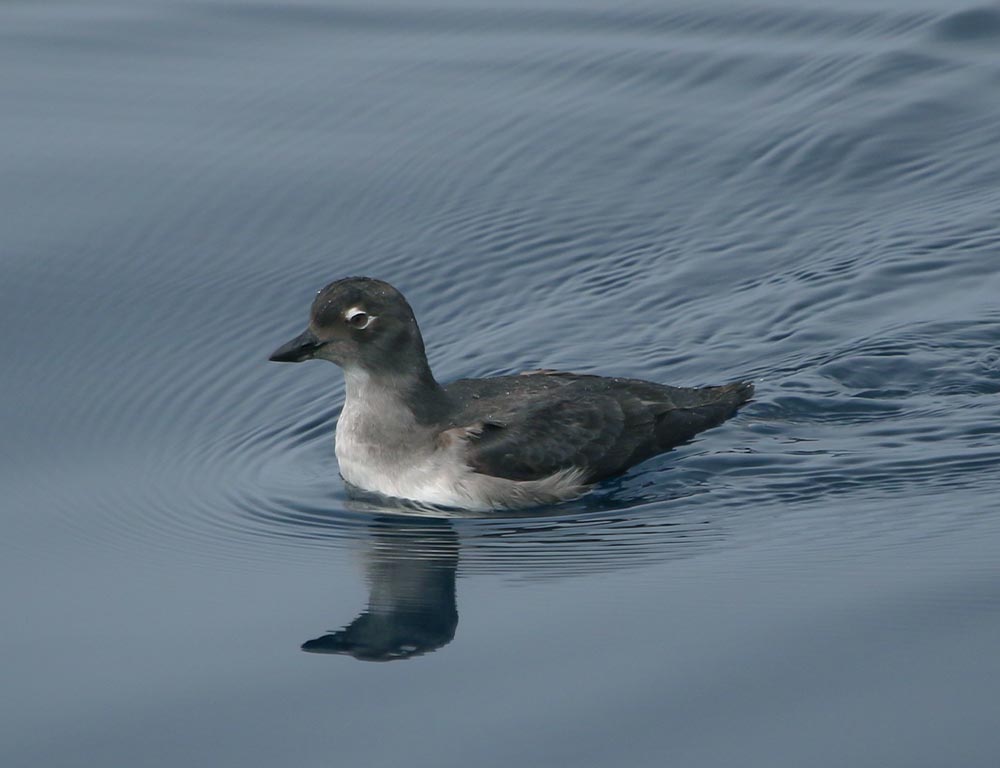
Cassin’s Auklet is a small, chunky seabird that resides in the North Pacific Ocean. It has an interesting appearance with its black head and white body.
Its short and stubby wings make it difficult to fly long distances, but it can swim quickly underwater to catch its prey.
Cassin’s Auklets nest in burrows on islands off British Columbia and California, making them easily studied by researchers and making them one of the better-known auks.
The bird was named after American ornithologist John Cassin, who first described this species in 1858.
Today these birds continue to thrive thanks largely due to conservation efforts being made across our oceans.
Scientific classification:
| Kingdom | Animalia |
| Phylum | Chordata |
| Class | Aves |
| Order | Charadriiformes |
| Family | Alcidae |
| Genus | Ptychoramphus Brandt, JF, 1837 |
| Species | P. aleuticus |
Also Featured In: Auks Species, Birds That Live In Humboldt Bay
9. Pigeon Guillemot
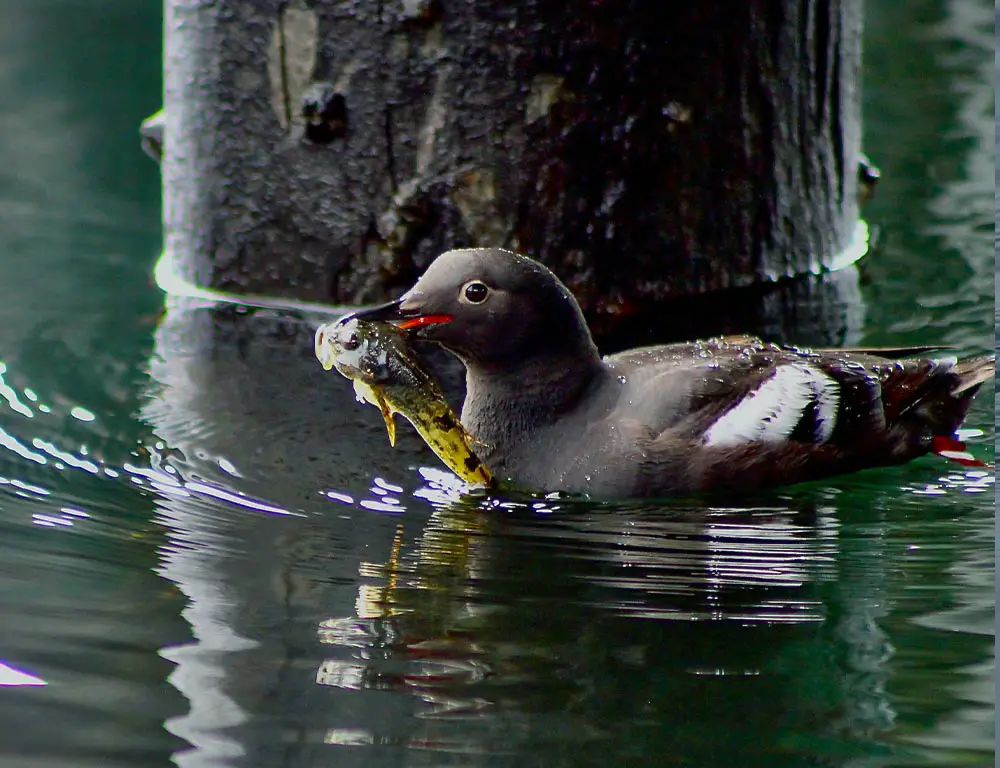
The pigeon guillemot is an interesting species of bird belonging to the auk family. It has five subspecies with striking black and brown plumage that shimmers in sunlight.
When breeding, they have a distinctive wing patch broken up by a brown-black wedge for easy identification.
They are closely related to spectacled guillemots and share many features, such as their razor-sharp beaks, which help them catch fish from the sea depths below.
These birds can often be spotted on rocky shores or offshore islands where there is plenty of food available for them to feed upon.
Their unique appearance makes them stand out amongst other seabirds, making it easier for humans to observe these wonderful creatures.
Scientific classification:
| Kingdom | Animalia |
| Phylum | Chordata |
| Class | Aves |
| Order | Charadriiformes |
| Family | Alcidae |
| Genus | Cepphus |
| Species | C. columba |
Also Featured In: Birds You’ll Find in the Sea, Birds of Oregon Coast
10. Western Gull
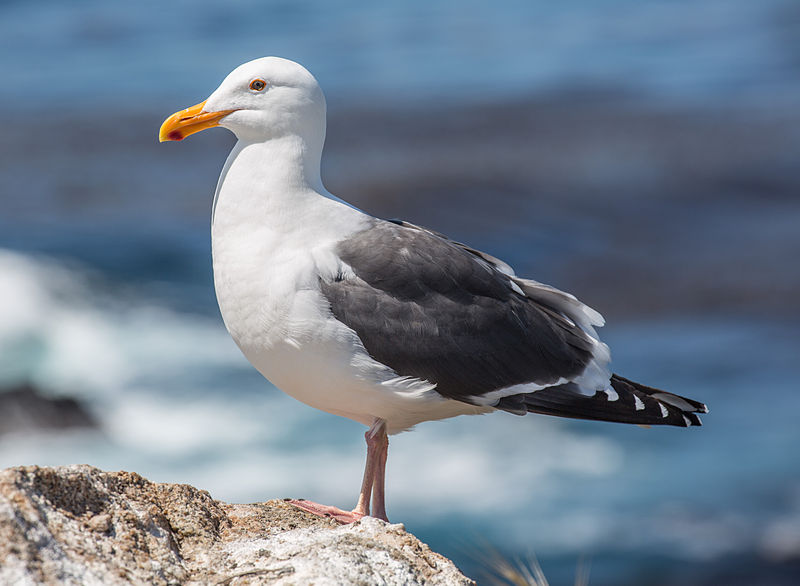
The Western Gull is a majestic seabird found on the West Coast of North America, ranging from British Columbia to Baja California. It has a large white head and stands between 22-27 inches in size.
Its upper parts are gray, while its underparts range from brownish-grey to white depending on the age or sex of the bird.
The most distinguishing feature is its yellow feet, which set it apart from other gulls in the area, such as Larus livens.
When available, these birds feed by scavenging for food, including fish, mollusks, crustaceans, and even carrion.
They also nest near ocean shores, with their eggs hatching anywhere within 28 days after being laid. A beautiful sight to behold at any beach, these birds will surely captivate you with their grandeur.
Scientific classification:
| Kingdom | Animalia |
| Phylum | Chordata |
| Class | Aves |
| Order | Charadriiformes |
| Family | Laridae |
| Genus | Larus |
| Species | L. occidentalis |
Also Featured In: Gulls Species, Birds that Live in the Ocean
11. Brandt’s Cormorant
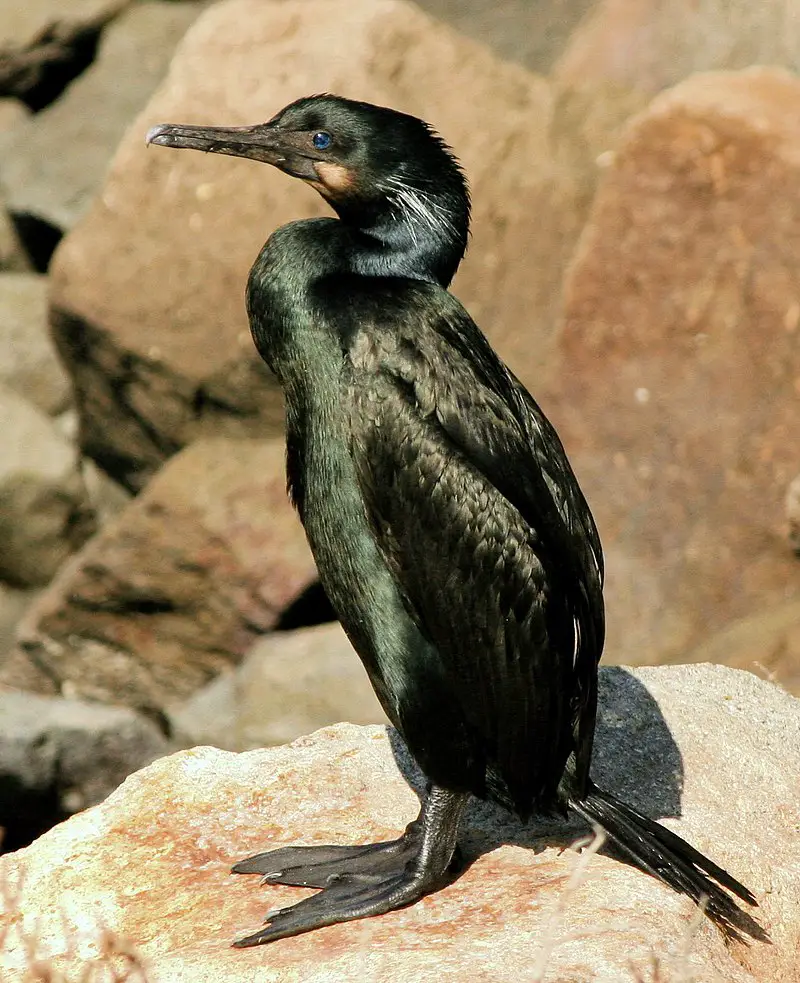
Brandt’s cormorant is a seabird of the Cormorant family that inhabits the Pacific coast of North America.
In summer, it can be found from Alaska to the Gulf of California, but its population northwards migrates south during winter.
Its name Penicillatus originates from Latin, which means painter’s brush, referring to its white plumes on the head and neck.
It feeds mainly on small fish like herring, anchovy, etc., diving up to 30 m deep for food caught in cold water near shorelines or at sea around offshore islands or continental shelves.
They breed along rocky shorelines, building nests out of seaweed and sticks close together in colonies numbering hundreds while producing two eggs per year with an incubation period lasting 25-35 days before chicks fledge after seven weeks post-hatching.
Brandt’s cormorants are considered an important species as they help maintain a balance between marine predators and prey by controlling populations through their diet habits.
Scientific classification:
| Kingdom | Animalia |
| Phylum | Chordata |
| Class | Aves |
| Order | Suliformes |
| Family | Phalacrocoracidae |
| Genus | Urile |
| Species | U. penicillatus |
Also Featured In: Cormorant Species, Birds that Live in San Francisco Bay Area
12. American Yellow Warbler
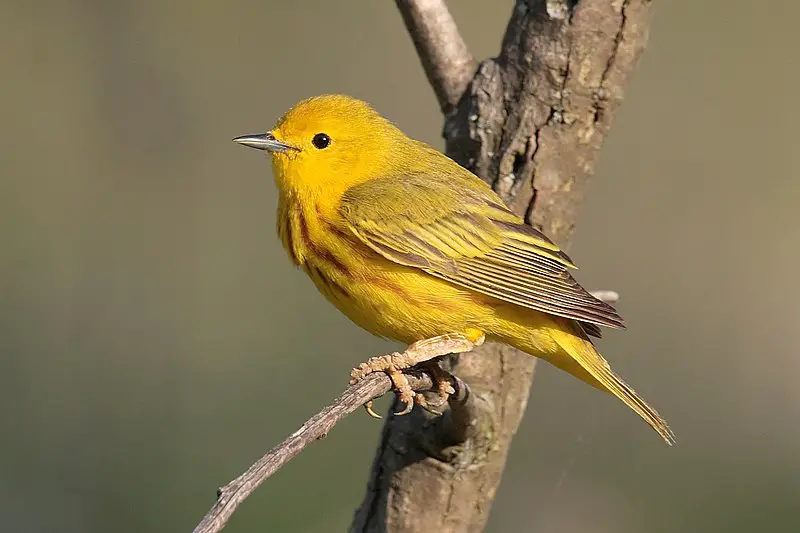
The American Yellow Warbler (Setophaga petechia) is a species of New World warbler found across North America, the Caribbean, and northern South America.
Its genus name, Setophaga, comes from Ancient Greek words meaning “moth” and “eating,” while its specific name, Petechia, originates from Italian for small red spots.
This bird has striking yellow plumage with reddish-brown streaks on their chest that can be seen during mating season when they are most colorful.
They live in open woodlands near wetlands or bodies of water where they can find food, such as insects like spiders, beetles, and caterpillars, which comprise much of their diet.
The male will sing to attract a mate during the breeding season before setting up a home in twig nests built by both sexes together high in trees or shrubs.
Scientific classification:
| Kingdom | Animalia |
| Phylum | Chordata |
| Class | Aves |
| Order | Passeriformes |
| Family | Parulidae |
| Genus | Setophaga |
| Species | S. petechia |
Also Featured In: Utah Birds, Most Common Songs Birds that Live around You
13. Wilson’s Warbler
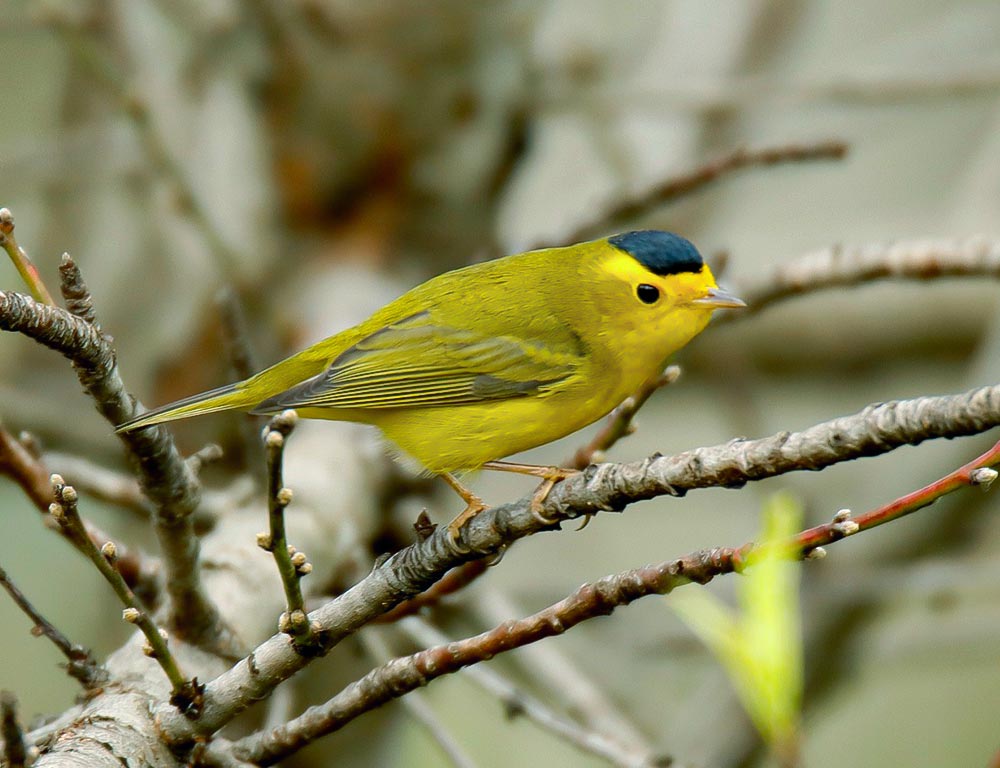
Wilson’s warbler is a small, brightly colored bird found across North America. It has a greenish upper and yellow underparts, rounded wings, and a long tail.
The male has an easily identifiable black crown patch, which may or may not be present in the female, depending on the subspecies.
They breed from Canada down to central parts of Mexico and then winter south through much of Central America.
These birds usually flit around low vegetation as they search for insects to eat – their main food source.
Their cheerful song can often be heard during spring migration when they travel back up north to breed again after spending winter further south.
Scientific classification:
| Kingdom | Animalia |
| Phylum | Chordata |
| Class | Aves |
| Order | Passeriformes |
| Family | Parulidae |
| Genus | Cardellina |
| Species | C. pusilla |
Also Featured In: Nebraska Birds, Common Birds in Saskatchewan
14. Chestnut-Sided Warbler
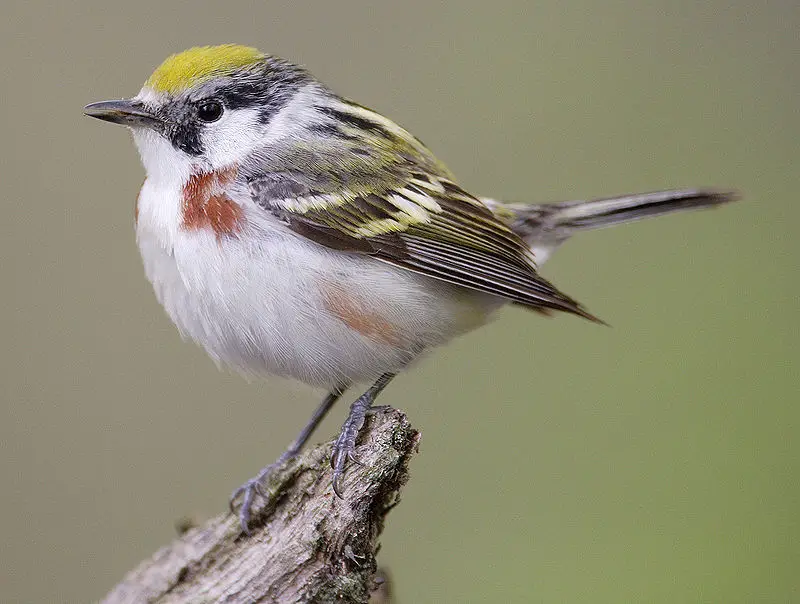
The Chestnut-sided Warbler is a species of New World warbler native to eastern North America, the Canadian Prairies, and the Great Lakes region.
It gets its name from the chestnut-colored feathers on either side of their body.
This genus (Setophaga) received its scientific name due to its preference for moths as food, which is evident in all stages of life.
This small songbird sings high-pitched songs from treetops or bushes during the breeding season.
They also have an interesting migration pattern; some individuals may migrate north during spring while others will travel south in fall, depending on their location.
Overall, the Chestnut-Sided Warbler is a beautiful bird that deserves our attention and admiration.
Scientific classification:
| Kingdom | Animalia |
| Phylum | Chordata |
| Class | Aves |
| Order | Passeriformes |
| Family | Parulidae |
| Genus | Setophaga |
| Species | S. pensylvanica |
Also Featured In: birds of Vermont, Adirondack Mountain Birds
15. Blackburnian Warbler
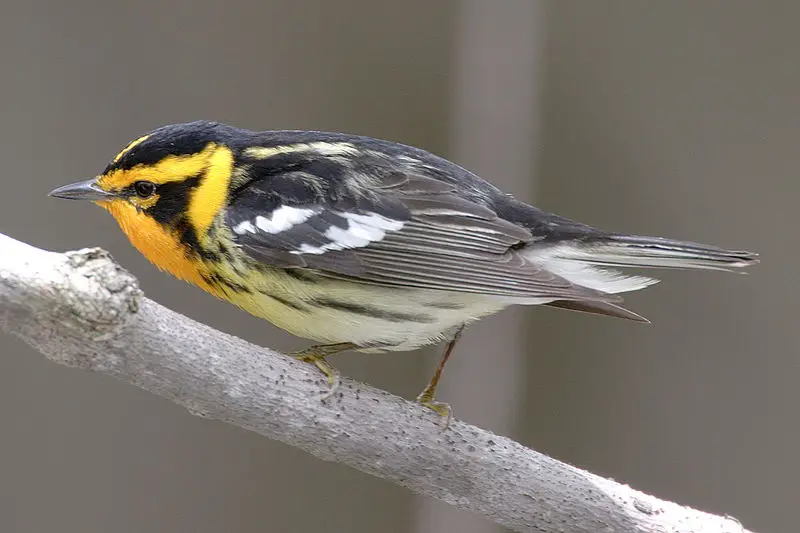
The Blackburnian warbler (Setophaga fusca) is a small New World songbird found primarily in eastern North America.
These birds breed from southern Canada down to the Carolinas and as far west as the Canadian Prairies, Great Lakes region, and New England.
They are migratory birds, spending their winters in Central America or South America; they have also been recorded rarely in Western Europe.
The males of this species can be identified by their bright orange-red throat patches set against yellow head feathers.
Females may show some yellowish coloration but lack the distinct markings seen on male specimens.
This species feeds mainly on insects gleaned from tree branches during its breeding period; during migration, it will eat fruit or nectar for sustenance instead
Scientific classification
| Kingdom | Animalia |
| Phylum | Chordata |
| Class | Aves |
| Order | Passeriformes |
| Family | Parulidae |
| Genus | Setophaga |
| Species | S. fusca |
Also Featured In: birds of Mississippi, Birds You’ll Find in Night
16. Townsend’s Warbler
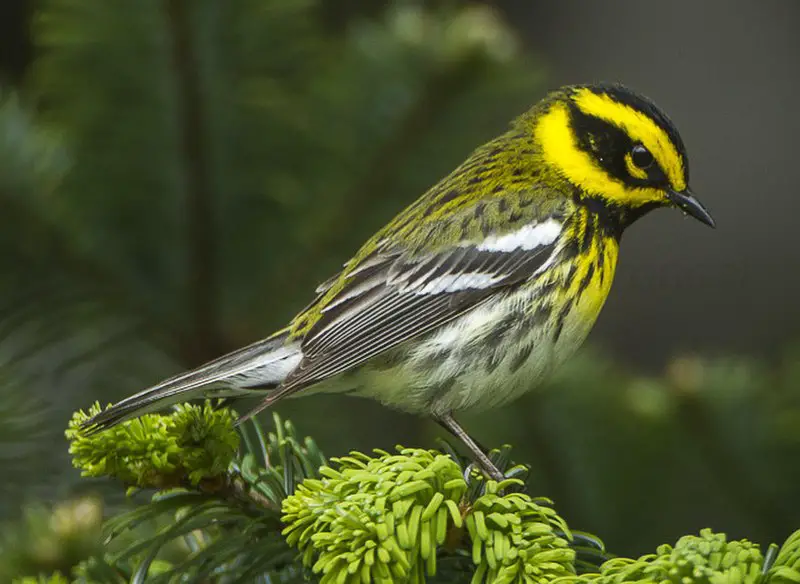
Townsend’s warbler is a stunning bird of the New World Warbler family. It was first described in 1837 by American naturalist John Kirk Townsend, with its type locality being Fort Vancouver on the Columbia River in Washington.
Its appearance and behavior are what make it so special – this small songbird has bright yellow plumage on its head, throat, and chest that stands out brilliantly against an olive-green back and wings.
During nesting season, they have been known to construct their nests using lichens or mosses woven into intricate cup shapes secured tightly to thin branches.
This species also engages in social behaviors such as chasing other birds away from territories, flocking together when migrating south for winter months, or gathering around water sources like ponds or streams.
Despite their beauty, they remain elusive creatures, often hiding deep within dense foliage, making it difficult to observe them up close.
Scientific classification:
| Kingdom | Animalia |
| Phylum | Chordata |
| Class | Aves |
| Order | Passeriformes |
| Family | Parulidae |
| Genus | Setophaga |
| Species | S. townsendi |
Also Featured In: birds of yellow birds, Birds in Pacific Northwest
17. Sora
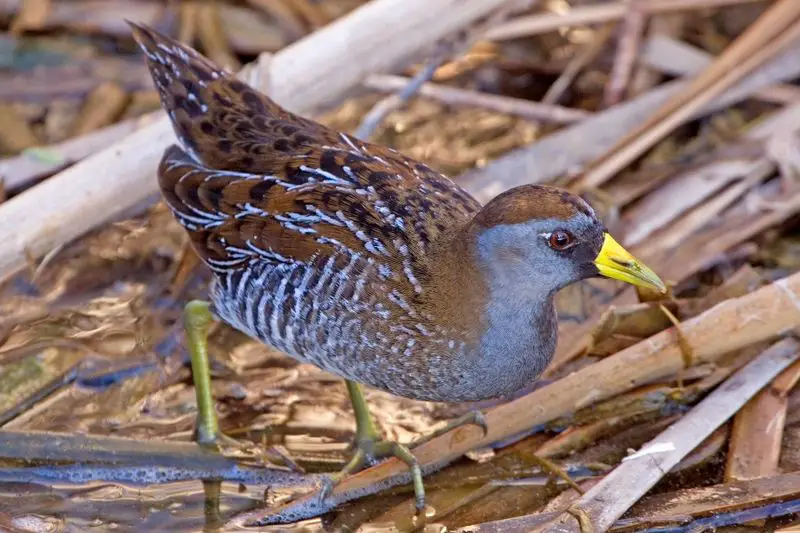
The Sora bird, a member of the rail family Rallidae, can be found throughout much of North America. Its genus name, Porzana, is derived from Venetian terms for small rails, while its specific name, Carolina, refers to the Carolina Colony.
The common name “Sora” is likely taken from a Native American language. Soras are small waterbirds, sometimes called sora rails or sora crakes. These birds are characterized by their brownish-gray plumage and short, straight bills.
They can be found in marshes, wetlands, and other waterlogged areas, where they typically feed on seeds and insects.
Despite their small size, soras are migratory birds and travel long distances during their seasonal migrations.
Overall, the Sora bird is an interesting and important North American avian community member.
Scientific classification:
| Kingdom | Animalia |
| Phylum | Chordata |
| Class | Aves |
| Order | Gruiformes |
| Family | Rallidae |
| Genus | Porzana |
| Species | P. carolina |
Also Featured In: Birds You’ll Find in South Texas , Wetlands Birds You Should Know
18. Band-Tailed Pigeon
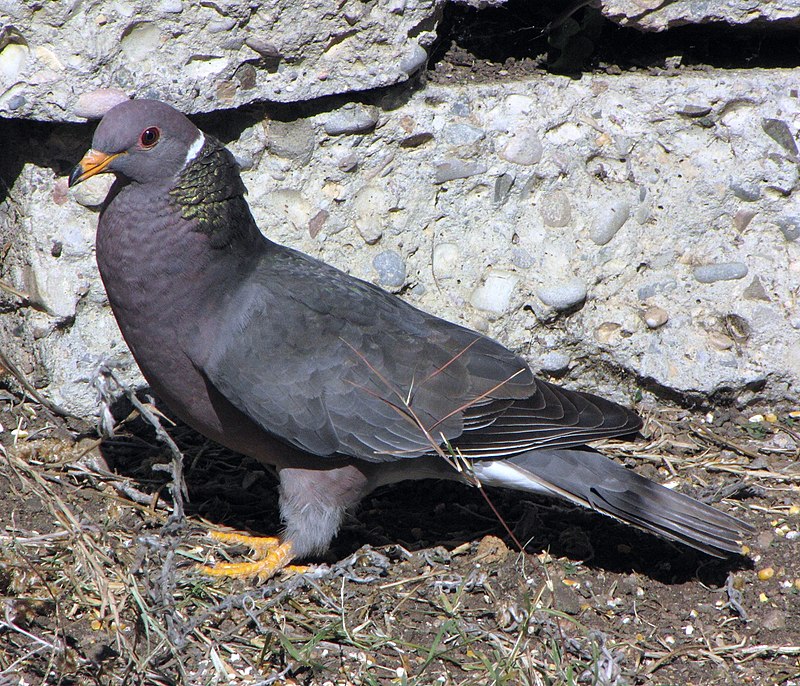
The band-tailed pigeon is a bird commonly found in the Americas. It is medium-sized and has iridescent plumage on its neck, similar to its closest relatives – the Chilean pigeon and ring-tailed pigeon.
Its unique feature is the terminal tail band. There are at least eight sub-species. Some experts even classify the species into two – the northern band-tailed pigeon and Patagioenas fasciata.
The band-tailed pigeon is beautiful to look at and is admired for its unique appearance.
It is also an important species in the ecosystem as it helps disperse seeds of various plants by consuming them and excreting them elsewhere.
Unfortunately, the band-tailed pigeon population is under threat due to habitat loss and hunting. Conserving this beautiful bird and its habitat is vital to benefit the ecosystem and future generations.
Scientific classification:
| Kingdom | Animalia |
| Phylum | Chordata |
| Class | Aves |
| Order | Columbiformes |
| Family | Columbidae |
| Genus | Patagioenas |
| Species | P. fasciata |
Also Featured In: Common Birds That Live in Las Vegas, Most Common Birds of Farallon Islands
19. Ashy Storm-Petrel
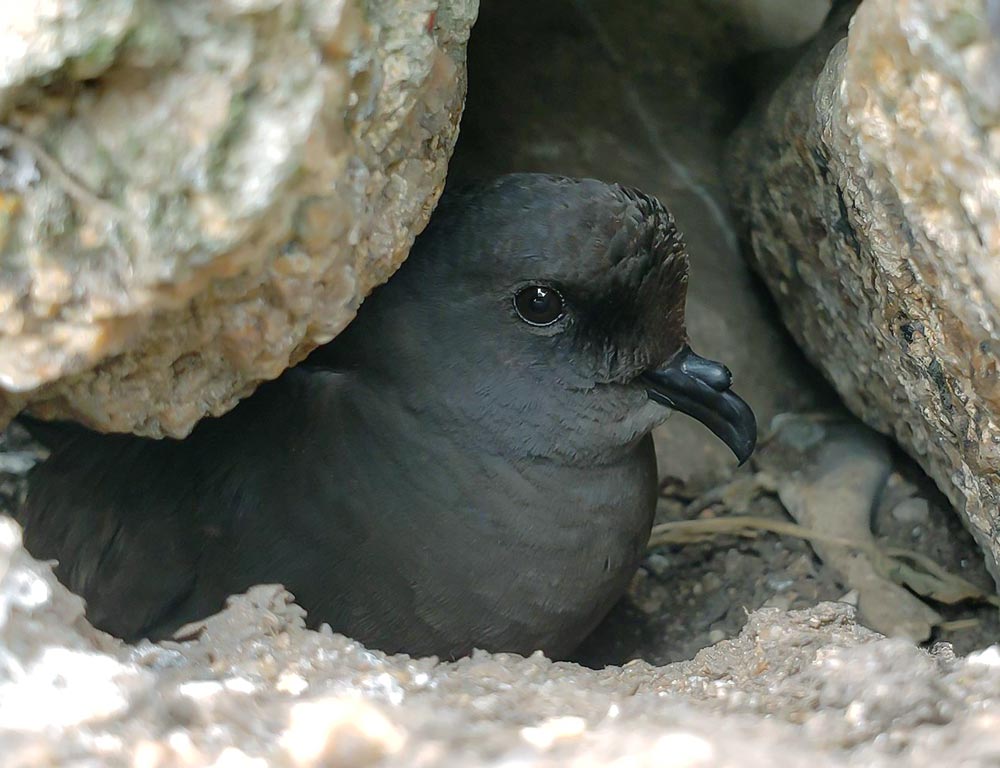
The Ashy Storm-petrel is a rare seabird belonging to the Hydrobatidae family. It can be found nesting on islands off the coasts of California and Mexico and is one of six species of storm petrel that live and feed in the California Current system.
American ornithologist Elliott Coues first described this bird in 1864. The bird’s common and scientific names allude to its ashy coloration.
The Ashy Storm-petrel is small in size and breeds colonially. It feeds on plankton and small invertebrates that it skims from the ocean’s surface.
Because of its limited breeding range and small population size, the Ashy Storm-petrel is listed as a species of conservation concern.
Scientific classification:
| Kingdom | Animalia |
| Phylum | Chordata |
| Class | Aves |
| Order | Procellariiformes |
| Family | Hydrobatidae |
| Genus | Hydrobates |
| Species | H. homochroa |
20. Leach’s Storm Petrel
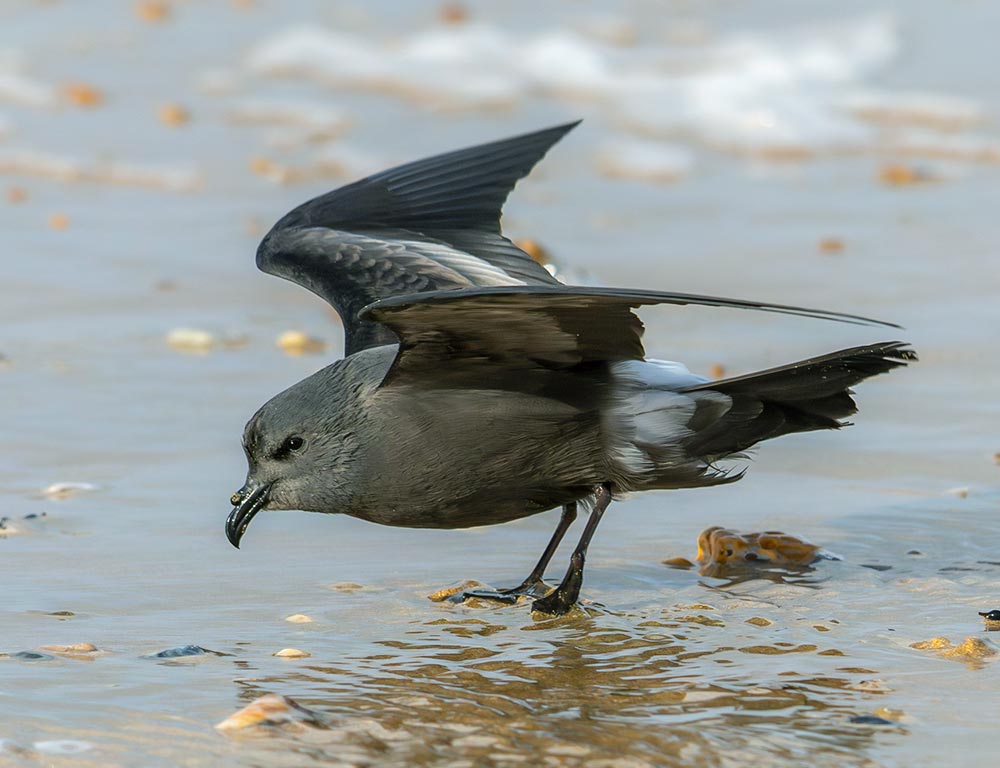
Leach’s storm petrel is a small seabird that belongs to the tubenose order. It was named after British zoologist William Elford Leach.
The scientific name of this bird is derived from Ancient Greek, with Hydrobates meaning “water walker” and leucorhous meaning “white rump”.
It was previously classified under the genus Oceanodroma. As its name suggests, this petrel is known for its ability to weather heavy storms out at sea. A nocturnal bird spends most of its time flying over the ocean, hunting for food.
Leach’s storm petrel can be found in the Atlantic, Pacific, and Indian Oceans and the Mediterranean Sea.
Despite being small, these birds can travel thousands of kilometers during migration. Leach’s storm petrel is categorized as a species of least concern by the International Union for Conservation of Nature (IUCN).
Scientific classification:
| Kingdom | Animalia |
| Phylum | Chordata |
| Class | Aves |
| Order | Procellariiformes |
| Family | Hydrobatidae |
| Genus | Hydrobates |
| Species | H. leucorhous |
Conclusion
The North Farallon Islands, a vital sanctuary off the coast of California, host a remarkable diversity of bird species, each playing a unique role in this fragile ecosystem.
These 20 bird species represent just a glimpse of the area’s rich avian life, from the ubiquitous Western Gull to the rare Ashy Storm-Petrel.
The islands provide crucial breeding grounds and stopover points for migratory birds, underscoring their ecological importance.
This diversity highlights the biological richness of the Farallon Islands and emphasizes the need for continued conservation efforts to protect these vital habitats for future generations to observe and cherish.